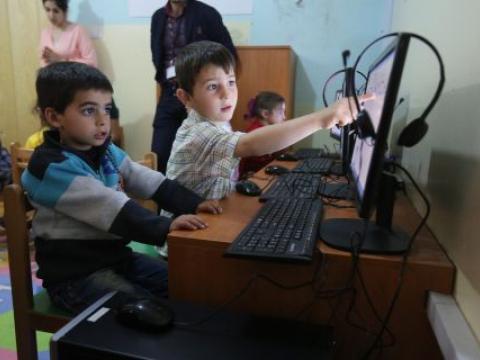Could a digital solution ensure education doesn't have to wait?

When children in emergencies are asked what they need most, it’s education. In Putting Children at the Heart of the World Humanitarian Summit, a report for the World Humanitarian Summit (WHS), children identified and consistently prioritised their education and protection in all types of emergencies - including conflict, protracted crises and disasters. Ninety-nine per cent of children in crisis situations see education as a priority.
A life-saving intervention?
Education must continue even amidst crises and chaos. Although most consider education a life-sustaining intervention, it is often life-saving. Out-of-school children are at a greater risk of violence, including sexual assaults, recruitment into armed forces, prostitution, and other life-threatening and criminal activities.
Education in emergencies provides opportunities to protect life with life-saving information, including self-protection from abuse, hygiene, and sharing other life-saving survival skills. Additionally, it reduces the risk of children being sexually or economically exploited.
Education protects not only against immediate risks, but also against future threats to livelihoods. Education can normalize the lives of children, reducing the impact of interruptions caused by crisis. Returning to familiar routines helps instill hope for the future, mitigating the psychosocial impacts of violence and displacement.
An underfunded intervention
One of the biggest issues in regard to education in emergencies is financing. Despite the evidence of education being a major benefit to children, families, and communities, education in emergencies continues to be underfunded. In 2014, less than 2% of global humanitarian funding was allocated to education (UNESCO, 2015, p.5).
After the “Supporting Syria and the Region” pledging conference in London on February 4, 2016, it was promised that the total commitment and partnerships from companies and partners come to $75 million. However, until a legal instrument is implemented, the promises are mere discussions.
Approximately $38 per child and $113 per adolescent is needed annually to ensure they can all go to school - this means the total funding gap is $2.3 billion - or ten times what was given in humanitarian aid to education in 2014 (UNESCO, 2015). The costs may seem high, the cost of children and adolescents not receiving an education is much higher, without this investment, there is no way that SDG 4.1 will be met.
In order to ensure quality and coordinated delivery of education, we must consider preparedness, response, and recovery stages. One way we can better prepare is by considering non-traditional measures to address some of the common challenges in delivering education in emergency contexts
A digital solution?
With children forced to leave their homes in conflict and disaster-affected areas and starting new lives in camps and other harsh areas, providing enough safe facilities for their educational needs is one of the highest priorities. Lack of teachers and resources are some of the major issues preventing the sustainability of education in these emergency situations. Additionally, the lack of funding makes continuing or creating educational programs very difficult.
A center which produces needed educational content as e-documents and multimedia for the diverse communities, including IDPs and refugees, with support from the Ministry of Education, local, and international NGOs, and in alignment with national curriculum, could be a viable solution.
Such digital hubs could be dissemination centers for curriculums that have been digitised, as well as interactive games, discussions, etc. for students’ learning. Video banks could be developed and showcased as part of personalised learning for mixed classrooms - mixed language, age group, gender, culture, curriculums, etc. Thus, in places like Lebanon where students learn in English or French, Arabic-speaking refugees from Syria can still feel supported.
Setting up these digital centers could help address the issues faced by host community education systems such as large class sizes, lack of quality teachers, limited teaching materials. The considerations of online vs. offline access would need to be discussed, depending on context, but if there is online access, learning could become easily accessible and utilised 24/7 (or through offline storage devices).
Digitising curriculum tackles the lack of basic resources. The content can be easily copied, reducing the reliance on textbooks. There are so many technologies available these days, from computers to phones, smart boards, and tablets, etc., that would assist the easy transmission and presentation of content. The issue of access becomes null, since communities could access the digital hubs, instead of having to hope to be admitted to a second shift (or third) system, or else, could also arguably access the learning at home via phones and tablets. Volunteers could also be trained within smaller communities, or even similar to home-schooling, to gather students at various times to ensure growth and learning.
Every child deserves a quality education, but right now so many are missing out. While we advocate for more funding for education and for the peace necessary to reduce mass displacement, we need to look for alternative education solution. Education cannot wait.
Learn More
- Learn how we’re using e-learning to help Syrian refugee students in Lebanon
- Read more about our adaptive Education in Emergencies in the Kurdistan Region of Iraq